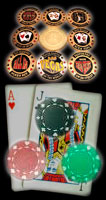GETTING A GOOD VIEW
If you’ve identified more than one good seat (or can’t identify one), one way to break the tie is to pick a seat at the end of the table, either the number 2,3,7 or 8 seats at a ten-handed table are the seats on the end of the table which allow you to watch everyone for tells, all at the same time.
If you are in the middle and decide to watch the players on your left, then Murphy’s Law dictates that the tell you needed to see will be on your right, or vice versa.
VIEW OF THE TABLE
When you first sit down at the table, you won’t often have a choice of seats-usually only one seat will be available, that is, the one you’re going to take.
A loose players often just looks loose.
He sits or sprawls loosely in his chair. His chips are haphazardly spread in front of him or stacked unevenly.
Similarly a tight player just looks tight. She sits upright, firmly in the chair.
His poker chips are neatly stacked by denomination, probably arranged in a triangle formation.
Passive or aggressive players aren’t as easy to identify, but they sometimes give off some clues also. Passive players can sometimes be identified by a blank look on their face.
They tend to not appear to be alert.
Aggressive players sometimes tend to look not just alert, but hyper-alert.
The characteristics of a maniac are twitching eyes, continuously scanning the table or even the room, and fidgeting hands.
When you have a choice of where to sit, the first step is to quickly scan the table, trying to identify player types.
This initial identification won’t always be right-but you’ll make accurate assessments often enough to make the few seconds it takes well worth the time.
An ideal initial seat selection would be to sit as close to the right of the tightest, most passive looking poker player who are easy to beat, that is, weak players, and does not have many players who are difficult to beat, that is, strong players.
Pick the Right Table / Picking a Seat / Theories of Poker / Betting Theory: The Odds
A Theory of Starting Hand Value
A Theory of Flop Play: Counting Outs and Evaluating Draws
The Dynamics of Game Conditions / Table Image / Player Stereotypes
Women and Poker / Spread-Limit Games / Double Bet on the End Games / Kill Games
Short-handed Games / Tournaments / No-limit and Pot-Limit Poker



